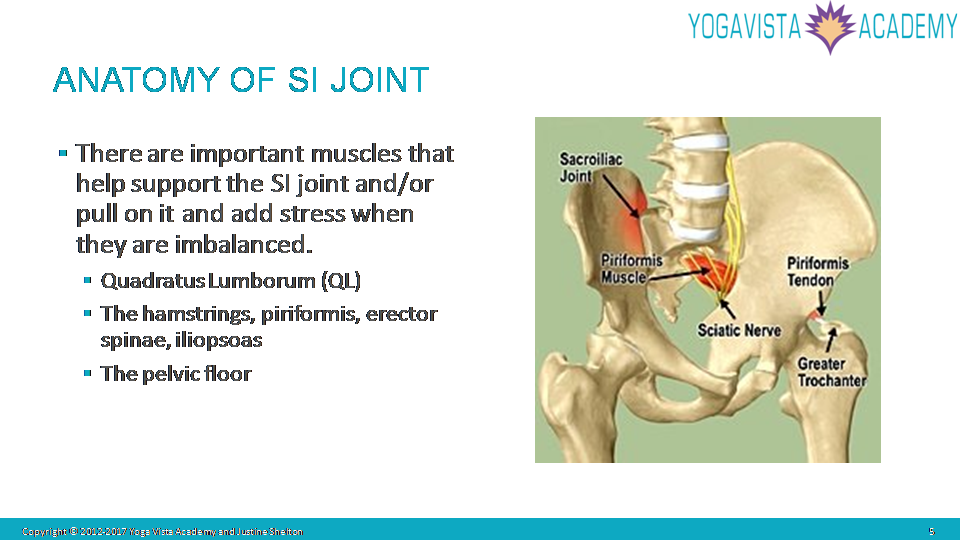Do Yoga Teachers tend to have more Sacroiliac Joint (SI Joint) Problems?
Do you think yoga instructors tend to have more SI problems?
Since you see lots of body issues do you think yoga instructors tend to have more SI problems? Do you use chiropractors? I have used a chiropractor and Chinese medicine for years and years. Its all good of course. I have noticed that yes my structure was off and I did need an adjustment, maybe I did mess myself up from yoga with practices that are not appropriate for my body. But the chiropractor seemed to blame yoga on the whole deal. So I’m wondering if chiropractors have decided that yoga is not a good thing. Do you sort of know what I’m saying? Has yoga gotten a bad name in the chiropractor world?
Any way just wondering what your experiences have been.

Answer from Justine
I would say Yoga teachers/practitioners definitely have a tendency to have more SI joint problems. This is due to the asymmetrical nature of many poses – especially when these are done with leverage. This is especially true for practitioners who don’t understand body mechanics and how to properly prepare for and compensate for these poses. Think of lunges, Warriors I, II and III, Triangle, single leg twists, standing head to knee pose, seated head to knee pose, Hanumanasana (front to back splits)…these all put shear stress on the sacrum and sacroiliac joints. The SI joints can be stabilized by strengthening the musculature around them, and then restabilizing after those types of poses – for instance, doing a prone, repetitive, symmetrical back bend like repetitive cobra when coming back to the floor after doing asymmetrical standing poses. Also, sprinkling symmetrical poses between asymmetrical poses to avoid too much sheer stress on the sacrum.
And, many (not all, and certainly not me!!) teachers are hyper-mobile….they may be able to do all the fancy poses easily, but they are much more at risk for dislocating the SI joint (among other injuries!) My teacher, Gary Kraftsow, used to always say ‘beware the hyper-mobile, those are the students you can really hurt.’ It is burned in my memory! That being said, I have dislocated my SI joint (more than once, unfortunately)…..one time, in training, I was trying to get deeper into a Marichyasana twist. I did it slowly, with breath awareness and axial extension, but – my femur is LONG and the fulcrum with that leverage was NOT good! (Learned my lesson though!! And happy to report it is healed!!)
Sadly, I think most non-Yoga practitioners, including chiropractors, only know Yoga as the wild, extreme Yoga….not gentle or therapeutic. So, it is easy to see why they think it is the cause of so many injuries….and, in some cases they are surely correct! I tell students, ‘Yoga can heal, Yoga can harm…..it is the proper application of Yoga for their body type and injury history that is important.’
I have seen chiropractors throughout my life, starting at age 14. I have a lot of respect for them……and, as I have learned and grown in my professional career – as well as understanding the issues in my spine and knowing what risks some chiropractic adjustments could do to my spine, I have shifted more to seeing an Osteopath and Cranial Sacral Practitioner. I learned how to reset SI joints in my Thai Yoga Therapy training – it is effective, but also a little violent as it involves force. When I was trained in Cranial Sacral Therapy I was taught how to ‘invite’ the body to reset the SI just by very light touch, holding and waiting. It is amazing, you just feel the SI joint slip back into place! I find when we force the body back into alignment, it often comes right back out as we don’t address the underlying issues such as muscle imbalances or chronic contraction.
How is that for a long answer to your short question?! 😉
I can totally understand why chiropractors might cringe at the mention of Yoga……it might have also increased the revenue in their practice!
For you, my friend, I say a short maintenance practice to work on stabilizing your SI joints. Child’s pose with wide knees, cobra – repeating 3-6 times then staying for 3-6 breaths, apanasana, rolling bridge 6 times moving both ways on exhale – only lifting as high as is comfortable, then rest with your legs on the couch.
Have a lovely weekend!!
Justine

